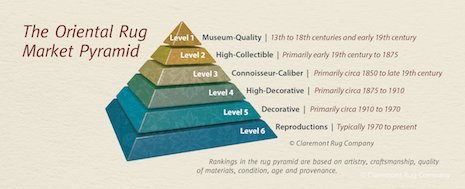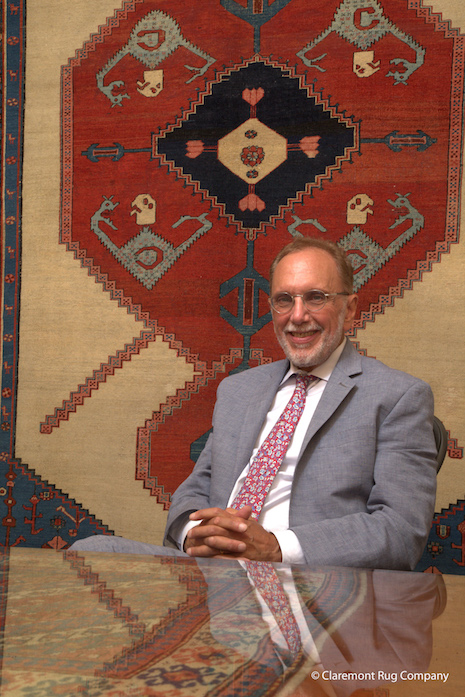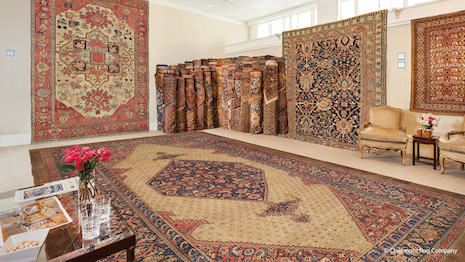A strange thing occurred when Jan David Winitz was pivoting his business. He ended up reinventing it.
In mid-March, the Claremont Rug Company founder was confronted with the same conundrum that thousands of businesses in California faced. Effectively, the COVID-19 pandemic forced him to suddenly close the doors of a gallery that he had nurtured, and matured for nearly 40 years in one location in Oakland, CA.
“Understanding the gravity of the situation,” he reflects, “at that moment, we didn’t have a clear vision of what to do. We gave ourselves a week to think and plan, after which we saw that we could pivot our business by dramatically upgrading our website, intensifying our educational program, and moving to an entirely online business model.”
New “normal” is sustainable
Now, eight months later, the success of this strategy has led him to a better recognition of what was accomplished and the profound changes he made.
“By deliberating, taking a step, deliberating even further and taking another step, we avoided falling into the ‘inertia’ trap, and we went far beyond simply altering our approach. We fully committed to a fundamental change in how to conduct business in the future. With a transformation from 80 percent in-store sales and 20 percent online sales to almost the exact inverse, we have reinvented ourselves and have a formula for continued growth and success.”
“We recognized that it was not enough to just survive until normalcy returned. We committed to a ‘new normal’ that we saw as inevitable, but also sustainable. We adapted the central components of our success over four decades: unparalleled inventory, expertise, personalized consultation and premier customer service, all integrated through cutting-edge technology.
Mr. Winitz can cite empirical and anecdotal evidence of what future success will look like. International sales at Claremont have grown 75 percent since March and overall sales, despite having to greatly diminish his in-gallery sales model, have steadily returned to previous levels.
 Oriental rug market pyramid
Oriental rug market pyramid
Rugs, from the Second Golden Age of Persian Weaving (ca. 1800 to ca. 1910) at Claremont are valued in the range of $5,000 to more than $500,000 per piece. Clients resident on six continents (more than 30 countries) and include more than 75 Forbes’ list billionaires.
“Our clients are extremely successful and affluent,” Mr. Winitz said. “They are used to having the flexibility to travel and to acquire what they seek in a stress-free environment. But they discovered that restricted movement provided them much more time at home to contemplate how to make their lives more fulfilling, minus the onsite experience.
“Collecting and connecting with antique Oriental rugs that were woven by master weavers 100 to over 200 years ago was something that they now had time to appreciate through our greatly enhanced Web site features and the semi-weekly email campaigns we instituted,” he said.
“Our conversations changed. I noticed that the average length of time of a Web site visit grew from seven minutes to more than 30 minutes. These were not people who were ‘window shopping.’ And what gratified me the most were their email comments to me.
“In the past, clients often sent us polite thank-you notes after a purchase. Now, they were sending unsolicited, long, and often-emotional emails about what the rugs meant to them.”
Mr. Winitz also noted that during the COVID-19 period, clients with whom he has not been in contact for as long as two decades have reconnected with a rekindled interest in collecting elite antique rugs from the Claremont collection.
“They mentioned that they were delighted that we haven’t changed over the years,” Mr. Winitz said.
“We still answer the telephone directly, no voice mail during business hours, and the person who answers is knowledgeable and adheres to our Rule Number One that client service starts when we pick up the telephone, not when we make a sale,” he said. “We are tremendously proud that our Web site is 21st century, but our approach is old-fashioned and personal.”
Claremont began doing things that for which it previously could not find the time.
For instance, the Gallery search, online rug education and wish list features were greatly enhanced.
“We’ve begun the process of creating a portal that enables clients to upload photos of their rooms, into which we Photoshop images of various appropriate rugs, allowing them to experience rugs in situ, albeit virtually.”
The experience is both dramatic and immediate.
 Jan David Winitz with the Dragon Bakshaish
Jan David Winitz with the Dragon Bakshaish
Education and communication
Another increasingly important factor in Claremont’s connection with clients has been the educational nature of much the communication.
“We have always had an ‘Education’ section on the site,” Mr. Winitz said, “but in the last eight months we have also been sending emails to clients that were entirely educational in nature about rugs, about weaving and about the weavers.”
Another longtime feature that has emerged as a key factor in many purchases has been the gallery’s proprietary Antique Rug Pyramid that separates pieces into six distinct tiers by their desirability as art objects to acquire for investment purposes.
“Clients constantly refer to it to ascertain where it fits in the valuation/collecting/decorating chain,” Mr. Winitz said.
“Our clients have traditionally been very tactile and oriented toward touching and feeling the merchandise, so to speak,” he said. “But that is changing rapidly. We have always had clients from around the world, but the pandemic made it unlikely that they would be visiting us in California anytime soon.
“What we have come to realize is that many of our clients are so used to the online purchasing that in the in-store experience was no longer necessary.
“I don’t think that you have to be a visionary to see that to survive and to thrive as an art gallery, you will have to evolve rapidly into what we have become in the past eight months. Yes, on one level, it was a ‘pivot,’ but what really happened and why our success continues is that we reinvented ourselves on the fly.”
It is a lesson that Mr. Winitz believes many businesses could benefit by picking up on, rather than continuing to wait for the time when their operations will return to “normal.”
“We have come to recognize,” Mr. Winitz said, “that what was ‘normal’ before is in the past and is something we have used the necessity of this period to build on to create an even more dynamic customer experience.”
Jan David Winitz is founder/president of Claremont Rug Company, Oakland, CA.
{"ct":"GBiPyr0Rom1QaCoWAs6y6I+A0MPKwWtLrsTpTyX6oKjSwFDB\/1E48QS9IA601HpvYBC8KDRi2pSs\/ssjsVRNpjeIA+kKQcZCD02l1Q9rAcmapcC9F1ZYgM11inK1GzseucD3fMv+lRFVlT2UUofuoQ5uake5ZIECnJ7GK1qkouofr+H8d1kuoGRM4f4FvYmOk5iS6ksg+Q8j7rIHbLJQJwBEYXW8irZnFxWl8EN1wtkwLNyRaIBN9WlrVI69LgShHjLq2gdNn98If0K\/yWjuL5Qzx1O0KHmB1+miLofyzrFHWnzYBfpPvt5TNzmMUe7uabcing+7Xy+7rvK7Q71Ums3ekvo\/hVNOUcF21MMdK2P8O5cnCjFGZjE+grYs9su\/bGd8ZpVhNAxGNyUhG2Y61D2q6ariilzEhcvOL4aOZvc6\/9SWYCPwDbU1PgaM24pSeBJDLRVIoHbe2K66mi0+KySM8zLQlTN9PPVGWwUR3BzXEE0CKQDAih+K4\/dyMhw0ow69sN1tgz7VrpuY1Ixv6q+W4K2bAvCFRUeRSBtKcaTdDFE00RPLYfQuAgNEOI+FY\/qD93YPUPjjmw\/Z9QKBusdkWyXl9GyJ\/QVkxRVL\/vz+Ztu1p25ljTVua5wrEAV\/03vCXiL0sapMLj\/eL2CV3JtFCYua2Qq\/Cv24\/91KBs\/9+giwB+njY6FtsiXUvzrl3DcwHrLZSW5HltCrjS8dx72GitNIhA79caKJ+9DHFeQHlGeI5\/DwpCt0nz6yAFPkFajSVf9c6cVdrigCtT5Pf7ZAYj6\/xWKdRjqnN2VJEe5BcMWlLRuWWCFM3GAE8PNrRSjZh3KkHtjC72b5XIxXPC\/ZAkUF5Xf0bK3c3q7+AYvp2opZoeOur\/WcFcROhu6YIMga+w42Ym44SmCqTq7YL3gcYyic9JJJfKHELwyG1qV2s19pnMHeaqWhKR5\/KcIQlQUFAPC+gzg2q3mh4Q18jgU33hA2Frqexb56pxcj4vWjj91Hn9+VEY1+FYIgHIhvgbNrkW63Bf87kRtdg2zWJR7N4Hw9qTWvevvgbmCPsWzePggwDRX8+DZnwSoxcJi1Jc7Q0RYpKrfOqMyYMCMCVOpAkrtMumSgP\/HtIZ6p6+htf6TG6molGP4qboHuqslNtmqi2JdKsZibnbI50SEqw2Z8nId6nSqdio2qBejfhPeCzy1RNtSqN1YcAOSObP7GK7JwHvRfS64T315VE2NlfRVRSgpzYpJmFvDc3fT4v++Ieg7ithM\/Ez6vm8TGiuTjObQorpg1mjUlboFseY1tTcBAUHlcE7v21AEQ588GGj\/2TPKq+G05E7xUJaUjac3sdpe4d6aBYKf\/I3Fo6hooqXCeOUm0JrXdi+mFO953seYOfBKy57E1pMVQn7oGra5TpIdJzcGR89CsFCnIsxAGXOBF7Y0iHEn53lGmaf6tjnewa6wUIm8bz5f91btydGsj2EtZvGAZUZRHl6stv8b4HuRyHDSC67CIY+7H4hTbHe+qmpudga+ttGav5mU5clHoPpBK3dQEk31fVE10KVtFXjVJcVnCGU5O1o4H0nQvc3kMUswtqPWuNYkb3zT8E0v3xTNOCRhfVQLeCHaiHTa9ig\/xT+lkEXzxEP2kaoXhDQYchMZVrjc2\/4t4H9TRab6sRIFc2x9+hnICRhEQFDMW9NpYBUlwoikCJsqreqgdf4Kjh0d5Gj2cXLlMzHOWeKTRdNlZ5NisEXWfbQu5GeeonMdBBTQ3zkfBQJrQFwrtnd4Z4ag3wJGCh6INXcPksg4EG9U40IZkXCEOki+OpMmsNUq1nlglDvIOxsJTFc4oK82BJOmCx5DkXELD\/cK799500GhRQsarjjORaz6R9IbRS+wGmoVWgsh3zkO6qbhNslHJVccb4uIw16LmOWueuZnHyNdatBOnQreRxrRjQTqZgPGEvIBZOb5CWzBmza2p+JNzmhp08ybzfdmuK5O+LJOip8SU48ag7FsJacCy87p3C+ggKbcP3j2f9nw8Fk8HEqXafNfknXxvptao+KNYXpR4qI\/lCGUH2T8ZUUlu5XMI9L0k2U4EjmtXU\/Lh7C\/6JcOO1DvI4IAMOrV2iKRM5KYQQW95MIb+5gifW76CxnnLMQkBdtpHxGIX+DjbiRQIK03aY4df8Q957SizlanoTD22pYheRA\/zYvEfg70NltBLtFA0d\/+dTOeRKlGFbrQrmugAu5jqw4ZhGgxsNAij9WMxEu8oPs2KvuYNS4DhE4aNBKYb2eToebntZzMk04plGys\/mxVjVONV96ExX4VpzIkVFfJvPLhZEOtSoSQn+G8tWHaAyYJo7CA+mDQ\/59yDwL8ODdlZC1PvxHkMbCwBCfV6rmfX91qqA4wwZCtantTIjWjtXymxgjfmBYLl\/iI+Vwp1lH3tU2Tc2e690\/rogf4E8p76mU5I3zEPUSgKx\/A3aeLnvmUgmOiTOvT18\/7hPl30+Ec5toVmcqIHkWelbbHVrpcBS8q3tNsXDX5PpQv1X7oS8Hf\/vNeFJzApEH6DQfs92eXEZYZ\/g93aHZU5rMyCOuce5eVdgbtQuZyap1aYxOnx9bwxDGyYEPyHTgL5nTzwg9obsOOPr\/JIQ3PCEZcwvxY9ELcQUgc72H5OJYIoPPZX5jdigHECEUJHfMxu54vZjVcw\/ljtalTZxtPlZigCEYzW1Rz+HkaMRSx1VnGucgUaWo1olS\/tannqtBTmRCT0G\/9cjneqzuTHWZobhvm715FdvHmqEqg+qZsW+Ibgm4i8fCDkM8p8btxgTa\/SG0OFhBoMka\/SFdlZzzlQwU4nJ0ljvVSzxVlAU8Q1d6FiKZTV6JBefKLExP4zFBl8Zp8Lngc5IgT7HG9mQnHrvPHD55qt65oJl9oO30lua6Y70n9C8ce0thnw1pYSk\/2fe9u\/u3eFUPigmj1IbE12S5QwROK4LQ2nPqmE0uilMhivZzikYXxiNuR0+UV1AI4mA9iSk3m\/A6Jrmd37fjcdVQuzgoJBuk2E82keIT04Q+HVxQMN5+TMLni1Izvm64Ri42iEtyEh2zxs3JzkzYhC+NEgBBLPmHO+LHYDEU2Rk3a2QcVjBa19MJS\/Y1bfpnsl1Axw3NmrcPmSDf1WanYRzB\/DuL2mrH9s1AlWNcsqraT75gclKVQJSsfYBUI5S7Pxrk2ShvH4iIivJY2XnUtJFO6JGy4GElICNRpISwbPDwq3vIqwkXHJYWfU1hLoytDfu2zQj6sPv3bH3bKCrBdA8mS6yzK8QIOwm6YWR004MflwbqF5SNAzX3HOPJKjTIxUPkAjKoHBRn1TdZrMQ\/9lWXu4UxDysaa8iR4xXBAlkkOY3B1DmxXP3ofy1317jNUm6wGD6dERANUKOJlKYN3xQL3Q1lw5lvPVGcJc5Iv7xMkoA9LYi1sYUbNaMT\/5PmwJ4ZE\/8jhJP84FfdzFTrHElWLDkdWuN7cU6rQvd26bY03UYXHq6C9eh0UH6Ap26zSrqXrvkP\/n7hGnajRFVTTrPZUe8\/dt6Xu\/pxXr6BW1YDqOzS5dw0mRWC2t61YK\/\/ma5KoS4pR4MMMaWRfCfc\/eSJjOg1pniq3QSVxkIENzEVEzkva7tjSDcKkehYWYz1m6egYAl9VR2RF7PFyYvx84ioPLX\/V6+x3WIO5ZKnTXj92MFf8MLJ31Czlunj8mWMgRncX\/bkQPUwQVxMipPLonoae2fkHvBSBOEE1WaXMapAOKiCDkGBajJNcPL6zQ7z\/ogbGm4IiWwmaTzga88jF\/SW7qN1h\/+dQc0edGTN80cXk6Hv3j+lCh9GTfWbqIAg+yPIN8aK2cA4CyyDxdp2nCTKDPqa2QEENGA6dX6oI07q4BwrO8fEjFx5g4smHbhrlWNN+SywTnWlrUwrwejrLeUXgkPZNtnDxxMh7rBnT5LMojxNdCvN+4pki1T5PxLtCuyhxTRjl1ZFw1iwOGqTbCPGX7Ay2zm\/ro1NRFQHvt\/SP95KQf6nbnd3qHv7K8rTuPUxRnIWLfRzeqQcMpK4uLc5nBCfzScxXQFaUdalbWskgI0XeTO5U9o7i6KRLaOm3QUmTzlmKHhT9PnelwxbgzipKLFAhiFAW48SsvmHYOWxBR9lAuOAWwn8O\/r97vbb9\/23tfNLyJP3cgqgKi\/O9bk44yy2K4BKQGekpguLedUQQSlYqucr+wGJJvvyXJFDkfQ0nLvZdjZ1+au7+8YN1n75H7Y3qQMy3Gtaufj9EkZ4fCDP5TG3hwgNmkVPbL5kFUO+bwRKwnChhc0IcxVlnQUUBwduNmUMQIz7\/MLkW5m9wV3E8RkVDKpHFUlN6823298kUrjKe+T7\/NOJ5aJycc\/bD6GcotiM1eO+dEOOUExMn\/hhsh\/oczre\/Klpp8Ig3e\/tQu6\/WuQeSsFGGbLTPoSmckCCHj4l6rmsZSibtDTQTiU02rYGvEP27wyx0DTjAiQlUzgWEqKRd3rczmn8xNgYoSScEpEOz9f75Kjx7iQw1\/UYrjjelzsG1SEbwOnfqoe2BQ9QxBm7k9\/a7Q1ZpE28CL62MEb6YqOyQbBCSEtLHR5hJJfqqok2q4MFwxfD3JcfUKf5lZ1mZ3n3JbH2kEMT+fT1ENPAzkW\/rASZIxMNmEkGHr9N4jGEmaZzdJvvQ0eKo79guRI+Ocv9wgHkRpwMa3dCqWbQuVOng83ughYl4tzmC92kSSYzLAK91IIEj7PrnrDy3xRUPW5iUoU48hmMu6iY6sstZZ3c+D8d0a1u48p6VDAH35Ps4aIsWhUJrO45I4+l4PJNQFaoO2bfjTgeF3CEb77iCiZEIevOwu\/RN7HNlFrRCaxLUszurIjcDLN\/EQJ3OJTF4qGxOdi\/+w7fWKp6NvdeLeOzBXAZ1QprhA2ie4l9CYZLGMitqJMVObJZJ\/9KRkYPlaoTXKb4uNEGlD\/FbCha6K3RLccKx3SWPR+mLilFQbZID0+HB51rxhNsmwqmXJYf2+7WtWr0xFerdhx\/Vu5CfLa\/hvNjTd7zoDnOoeXIOxHBTVAMqjv6RIZBQxt2pdUrnW6ITN19KkXKjd1qYaf2tkT3Za1Swyz8rOGmesl2RtaVt\/R3rB1AlfvmXDd1ajpr0EpoGBEEq97JS0pLjbc2+VCrPYNdpJznkqItNHb\/+By5WDxVno3HpvNtMKDHnYF4Ws05D9q+stn\/gZHW4DDGYcVwWv5OxQW2DFjPhmX6YyW\/5zZ\/8SeEOwSd7ggrm7xJwmf1xf2s0wQKfNxOKBDWjhbc5NWrKXZ\/tMQL1HZydX7Ab\/++r4xPWaIQX2bvMihN+zosFmQhdidXwUJhCU+k1nBDNr+f27tk9HcbCihklEawuMByFEavsmTDs\/B\/it\/l9ijYuV7P\/MxirpU\/FUU8hmvTdiXEAyhZNuK4oqcCnBOrIoqtfzL1dgLiSjWZeD42bdUns1+iUjtxFw9Bx0BvdqeLC+7\/+lPONFyb0rvqH6uMctXEn+euVfg3yoCJHkbL877p\/UrwhncDALMH9HSlXFR6Br5pFKvRwpHSqa7ExtRQpXZ3a\/uGZrR5r6WvOljYPXTdBW+5b1jz0cmqWJVHGb5CNl8VmkCod\/nkmsVNjzkIv7pvDBWVVZoumoKLUm1\/Bd8p+bGkTb4l7ujaDMly8bAkOnlqnGC7v23F4szxaJZ\/\/eInJwd+\/GgiU3KyyyZNLStLMO9ZxV1NVJ0\/nh24UnH8cT2T8n1ZumUP9NyoUqJJTxCyDxcIzPiZgyzd5XbxABLy2fqFUonzFetU4gHWUU\/sDjDf422cxFTU3d8w+vPQ4ceULlK7V0V6RecUwca1RnoBZ17KExBDdDTNovQfKb1vLK4nwqhM+JrxMfP8x5mm703uiQwJBgnqkUbQfwwccOWgeHIKPUdapCRwG1CozkZt5zluyUuTNvHwdtaVc4bPR4kGmponpakluKiq+6pxZ1IYFfrO0BtJBanSFX319YCdRDvHJAeXjb\/5IPYPcKiOMMP5aTaZ0Otx4nmAqw7vRAIngyybblOu9oCPhS89rb4PY38swCKEJzTIc0Fjo4Ld5l+Js2Vav4m37SFpRv\/6yveogP\/Ql0Yb+qHzC1xqGG9+nwBpfdnKsfWQmw26igyo6JgZyPlM+2VGDPTSzoT4+prEhjZV9yGNAmfEt6NYxd1FodyqvNp5HccyzrtSnNn6AVMYyIXDw8NAUwxC036Sn1U\/ISGFw3vPJuH2KYK8+wR9noinYe8XWNneF1+wXQbudcKYnchoMSbNtcmfz4lX6L5wjclvsmjmOxElPKLaaDjLTVS8+DsphfL6GBC\/V4kYT0KBBanAJOz6lrr9XqCQ8dvlGx5hflwdK5tgKO4bfHtDMxqojjIqgqJqYzGLC8L\/gIXRpfEfQwNIREmqTw5KEuLamtGoJzM9YyJkzEpyzp\/qEOjIVuumkgoZRD\/DHRPqRVMjYnZmIdlrloC2qfLhTinO3n7OURCEC7fkGU5Y+gaYrD9mpfScXi46PaKOmS3oMfQiQG2DDjv1JMSRv8SF5XJ1zY4nILWPVwZnEXPaRI2Kdzh1JeUQg6Y\/OrcnDSzqEirLXdrHJBpYLZJGrtwOW1roz6WRg5VgCGzg2L2Q8agUcCvNuLBcowAPq7UX0IVazLHa1NnYPTtIfz2lY6p6FKsBkznJbKK0DYjgCj7EqUKrgBx\/SnsN17XSiZLYZtYiyl8qC4ZehH9IrBkYMIMWgXKcsIVAnDL97kh06nm5AoAOSXRPL9uTCVAf2ML7M\/E2GE6X\/OBnq4B59MFXWfs8lX0RRkLWzC6x5kx0rIcRhvFu2PUNjS32IdOMLjuwFRB781bW6TU+MZ6DUzaZwogX6AyfoydPP6KqxO1SQKsRmwfmO7o9ix40bu58S49CrcuDiJs652d3c+JrYpk+7ZJnALMQJZMQk4KG3Ur5AMcqpvbpIGmzFq5CjrqbYdw6BLv0NR6pXr5dG06nHz6D5fZoZoXlu+iGNv6lCcDg11GPY05lVvEyiAiteeU4q9obBJfoK1f0i8RVIlJ8gbFsP48r1+DKeEEUFlm+Td0fwxWWFFM7BWPjTM98wUTUYUdaN0sp+vA9es8tiMbxpv755+lb2mUNmMy6yXC0oUM\/ddJxssIxgUit7ng9ZjWt+4HUY2i+hsPXAYbSdJ2pBFKNooxOgBNsx7lWKknhJzpl0RpaXUjR2o\/4CKPBALJxPHhpmEfBwJeBAZxPDQWNL8mXyRO+y45Otdzb+NYh1Htw7IGspxaGinlwSU7gdpV1J7Ir4SX95UekTQdKaZewcknUGhm7LOigthP4guqVMq9de1\/QzquDhQwWIj6N60E8vii0ChzpzDSAN+lbteOxspATzQ7aWC+GKo1tb91Bmp35T9D+OvFFchctlHCCGPIEW+rdegXlM\/bQuBsR5KhHq5o78WtXqZQOuCQR6qHYnINsm0B\/TOKhN7\/q+kBiabUXoY6kjv\/n7rtvGI4FyR5Gu4b2Fwdgm20EQXcAtdPFdKPdwAwehtmDbIIcCXrXVJq2OzF8JFVxwFLo41zK4dPfVWA4LNky7MjXl8oRd0Dtl\/TF7tzXN3PfeupOdJlhqsaIgwgg+bAHY37oZlETa5ZviAbhFpNHyXviRI0RAi7t4QKVZyTPUAr5KMoINjLI6m6guprTZ6E1FrmYUMJP\/DyHR4+nQTOSAzsQpdJpTS6sj1IS3n3lHCN+d8JswtwfZajzlAhMmwcMG2SkQYmnOR3IWGsncRfjuhTYwwmHEYCFeCHG4E71AYDwHSx2IAc3E8C8o\/TqJDw0U7g0Pd7NV3r7+fzYSdPyUgbl2brAtOLOvDLJEDftlmV7MOmvVpS83+GKZRBWj2zWO50GKaewPMc54\/o+M1uzk8\/2m6bMA0Y\/wcX\/Xdl7I5l3bdVGx1qM9H3LsG+9vmg7xwdWnihQuhuGoG2Xf+ENUQ\/zSfe\/0fr4x863EO6GZYOBT1TqNKPfDG4BVCwy5cv\/pNn\/xrZXWbTWLnb2FgTVETxWyenbakTf4L0\/HMQZ8dFDwwXpjQS2vsvH1XgXASveDBXumhqzS6yiROyx6qWXEX5zXyg6W5M1ASG1DGVLk0\/aXwABd1SPxCqqdfx0rTNhQBUlDpk8D4xBebA5iIHQYDRfIrMcH\/3LjHuEhl6xBhllcMTOC9lQFdhT0N\/LuIto\/Km8wKNxXW\/ci2jd3wq3KW2nEBCD6XOwMgoX6xU7xKxwNIWGq4B\/IPV9yto7LR5RTOY2Hy97SPhQFWtE6xZGMVA\/dKsP6sGQ57YQCtos24pkYPgiAOlDfEnBv9C3FwOQm\/+TZgeaBvoGsXxG2fRUsHdFuZNU19Ml3Cr+2tojS\/98ecPrO5VrIDDtlBdjNgwmyay8j9fwcUtfWzjawP1UXin78dfETJ\/ZTKmivkRZdUdzbQ24tsP+3mlsHT72NTP9ZQTZgzu8czxVR0pcXMRU6h2nQ8ql6aZqnbYTCy53CS7eRvAPAczUYgJes5QrC6y07QS7CVT8DUePy2xyYv7GnYPVfKJ9+50+LvxfLvHwCG+RUjrEXf5PVETul8YwXrkEiEJlTKCQlBvieI\/lbQKk7EUw8HrM+dhnl8+rS\/RHDe2y6S30SntBT8mfKPyrD9ng\/zDBZWwPyhi5FQMZD+9xTWp9sdp\/m7ZN3vDkd0IDV9i7i\/ySe0mCvRUl3VIQSN+3qwUV39S5gtHo6\/bmu2t9S36WB9Tl8KKyStI62e19OJjqkqwUNiPtbxzaZLZv+4WnUF3Yllg6Q7Cl14IXc9R5qlQfysxifp9YPtJhDgrHojk0eMiB+0paQqPF1\/m4jVEk2Uk+tbOAOVecqksu3doOe8xIumTYHIKYdi4Lyg8BSn9KM2UeCBqh5pvjB1qfku0QdOGmiNGx2y0bKdm34ttYrOaWW3mj8zl0WAPBy3pEOzrVCFY6iqHbYJf5JHE3GCYpARnmcySxGLLBztcI743HPpgoYWj4niNUSAHsD1TaWKEOaSTjxGWOxUFziUPb2Qz9afj3pyH2N32zJNS\/xI9WMXMt8vfdeKlmbEwXBAfci\/wmtKd\/MAdosFkO9vukXvxU0ZqDTTTxFVoMGCTrQx0OzqhoR0GQjntRXNagMcm9yUz+S5BzHm0jztEDjjtffb216+QzdRDShkb+LWqg28aeZke9XMhs3fCwTpLK6QuzJVKVJ7d9gmln\/OVC1sEwadNzqIkPTFgCbalo8sTbhEBGY5KTGwjo3YVJNkkgVnDqXDwNXt1gtYSqigjUBw7B1oVukAcxgTDaLY6zJ+MBLJYV\/VN9k7ccRPyqZmhzfWNVl6air0JiNnTyOEjMo+BiStTuMFi1v1fpY8HKxdPJWwG4VnMU6rk1pispfYURE96jL1WTgUXd+o3TGLn35QfM4BBya0nZ07wlZV7GwoOw0dP+DV89\/qhwah6dQvXDt90t9s9JZakRB2J49FZeuGj6hzmldE99lcD3Ntj9heZaAUS08d8TdngjES5FvDSi9gh6skYVJlyCS5+JP2UJS7+SGeUnC7WBd9ki34WKV2JkffZToqi07CI+j6GHMQ9DUL6i84x7cYMKEbmEKCiEZlmL3XTqNoUnMCCGr2Vxge0kKVUZhxVXaKFCzwp3axSSBhJJPYVhRC+kc+kSwSnfB3\/1GtMHFkcJ\/Ga1tF9doxMf7WYDe30Cdsy6lAweXqefcAkp4hWFMp1ptyV8QOkPndPIS525lByiWxQo36v7StI4O0bfIW5ktpZbDno+\/jrtmyhpVrz0msSzNPOgsvxs7T\/MnlDUGYsoz0fV1+X8WVqXAIcMrJx\/faBTfMA0JIMz1abZIZxMZ2uzbSpwrFUIyubddblFoI3BFJKFMdAqBdF4KP78DZ1lejD4TkW6KsE+2PgDPK0I6sL3hH6nF+4V0OtJoa3sIIWwnk88AEtFvnjgmfNU4wDVgESKRRAHdK30pBvsfqDByx69MjvVZJPDMQgnesjplTpzZpm6GY7puvkSl1COV24mtwWTgDrn7KwJYISmJ2O37O2gdcNWA+pH8raYHEdabCQWg6dQWOUf\/wquvcb2hza\/Wy7Ld5E1OlzOERTmdyTXrQ2TnqQY4Ds0xUhzUBbpeNKKuaA8EUP+1eeQOgZ5A\/eYJI4o0jl2jnEkpai87BBs3ZLlA3tDIo2n0OrPjMFokDyhm\/mIt6YFRZPcBKnXqS6MPzCc1VzFHv2pZsffvuCWToxarpn4MG04hoAmYi2lc420b+P9cUKktpHe5YNJenq+W0H\/ODqZqocOhNXIKLV\/WEEpk+kL\/AAHOyZfYkKewIYvw59ytUbS9c6+pWj45X8+7YfMKRh9vk4aiT4jN5hrg5bz3QSLRmgRDTp9zE5CxZUD\/HrGEOT2glUk80ZXekPm+OfoCfvAv\/PPkAmQQiiRf+WfeZIsBODzZ3C6dtnISOyhJKNyLhlRvqvq+hIWKO1WpQyOwCOHD6RWyoIbr9bPqyqpNkYqrLtYIAyMWAaWfcagcBVBwXSgPKqgIRcA+D\/\/17U4ELi3lSK+idsFD4Vm882v5LuCuFybXz7le+SM2w3VycfDMquBsa3uyN3zTrxLTzWuAJELkbTsN1F3KLvTfD+1b6XrsvE0xxjxOnH3mZ\/ZwU2RxeEzt9B1boRHgVeWx\/iEBIj9AFZu55E2ykCzL2RYZYuOq9hPWbpAmJrlN4a0GPncFVjmAr4RIr7OniRUYAukpA22FwdwCt6QS4tmnTWow3QBIMkZGLng22ZK7TV1BaJXGnyGfFG5YYNZYmFq0bR4oWAYncXDSq6SGReSKWvcIo4YjfzK0\/1AgP3AA+5ARaZgg6e0EWwDoqLWlQt6UTfruaiscyHSgacx8kJ2tb3MeTsOxKIAtMd1qkc+CGda3ObktNbn8=","iv":"a8ec80fb3d406bb8e26311d08f7cba97","s":"655669223136fb32"}

 Claremont Rug Company's story in Oakland, CA
Claremont Rug Company's story in Oakland, CA  Oriental rug market pyramid
Oriental rug market pyramid Jan David Winitz with the Dragon Bakshaish
Jan David Winitz with the Dragon Bakshaish